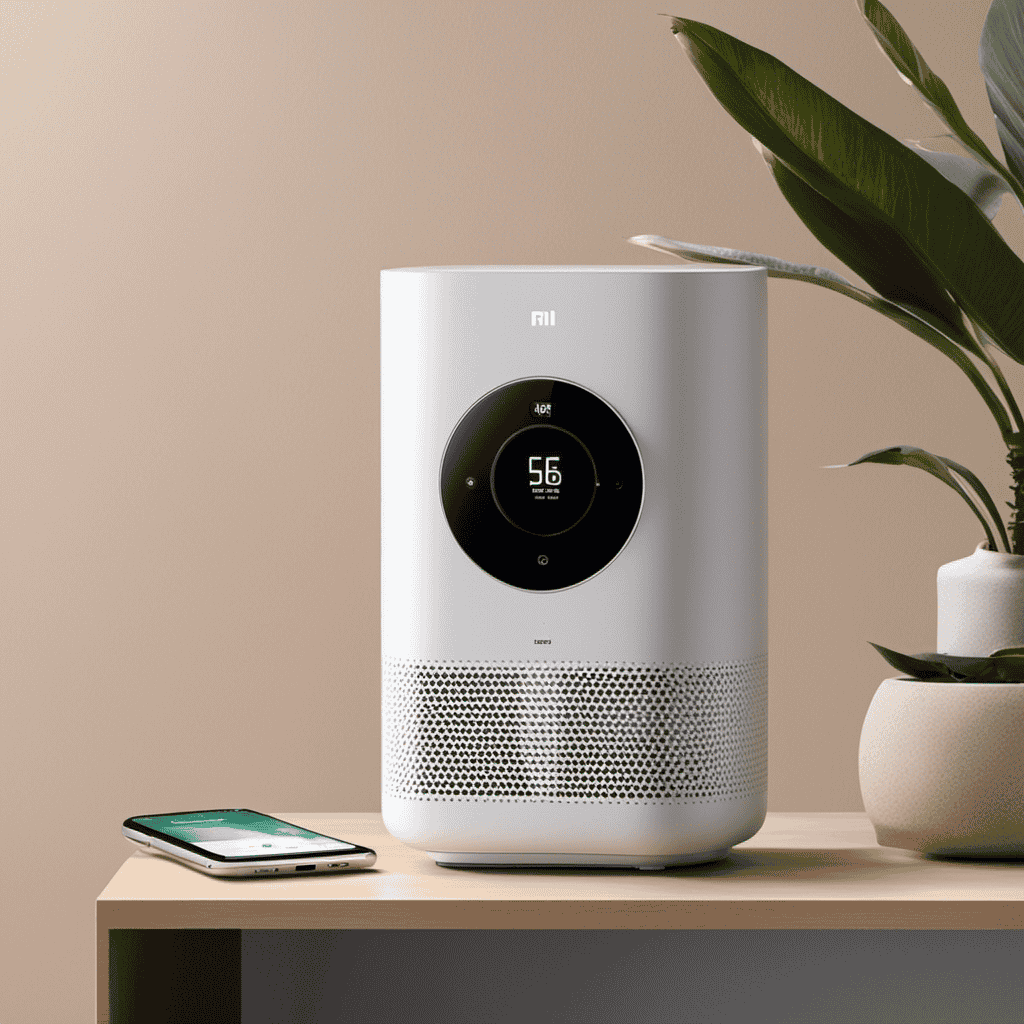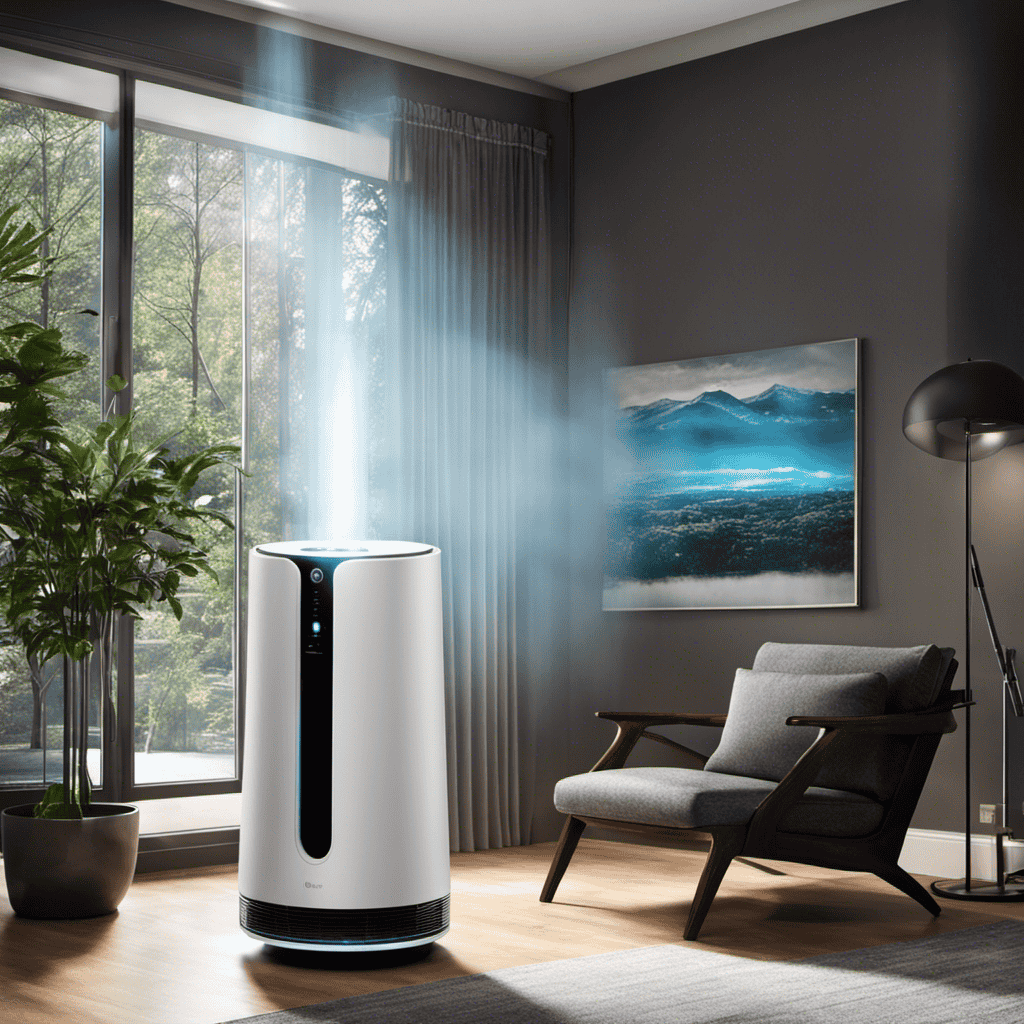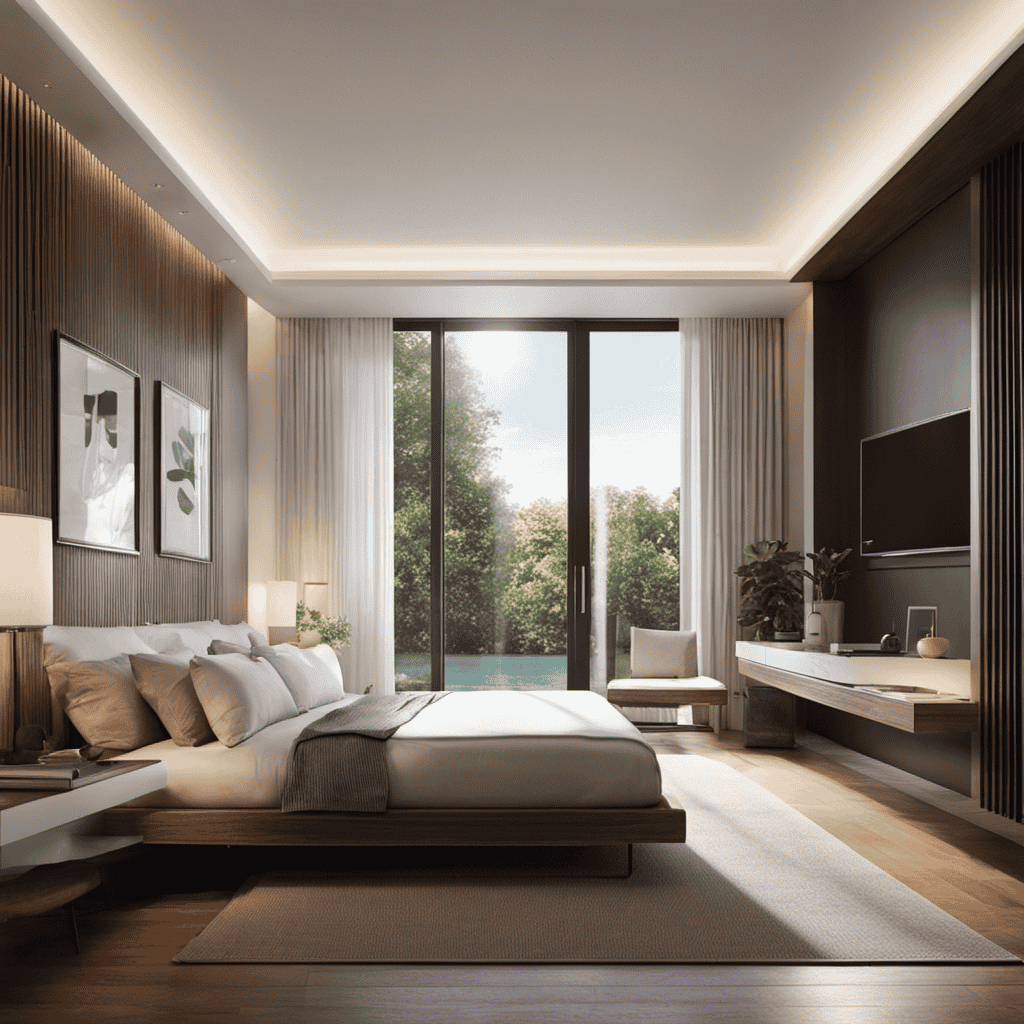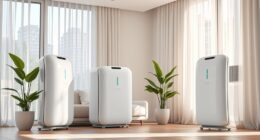So, you’re curious about the actual benefits of an air purifier, huh? Well, allow me to explain. These compact gadgets act like guardians of your indoor air quality, relentlessly purifying the air by capturing unwanted particles, resulting in a much cleaner and fresher environment for you to breathe.
In this article, we’ll dive into the basics of air purifiers, how they work, and the many benefits they bring. So, sit back, relax, and get ready to discover the power of an air purifier.
Key Takeaways
- Air purifiers use filters to remove pollutants from the air.
- Different types of filters target specific pollutants.
- Investing in an air purifier promotes a clean and healthy indoor environment.
- Air purifiers effectively remove particles and improve indoor air quality.
The Basics of Air Purifiers
If you’re wondering how an air purifier works, it uses filters to remove pollutants from the air. Understanding filters is essential to comprehend the effectiveness of an air purifier.
These filters are designed to capture particles such as dust, pollen, pet dander, and even bacteria and viruses. The most common types of filters include HEPA, activated carbon, and electrostatic filters.
HEPA filters, known for their high efficiency, can trap particles as small as 0.3 microns. Activated carbon filters, on the other hand, are excellent at removing odors and chemicals.
When selecting an air purifier, it’s important to consider the noise levels. Some models produce noise levels as low as 20 decibels, which is quieter than a whisper. It’s crucial to find a balance between effective filtration and minimal noise for a pleasant and healthy living environment.
How Do Air Purifiers Work
To understand how air purifiers work, you need to know that they use filters to remove pollutants from the air. Air purifier filters are designed to capture and trap various particles, including dust, pollen, pet dander, smoke, and even bacteria and viruses. These filters play a crucial role in improving indoor air quality and providing numerous benefits of air purification.
Using an air purifier with high-quality filters can reduce allergy and asthma symptoms by removing allergens and irritants from the air. It can also eliminate odors and unpleasant smells, creating a fresh and clean indoor environment. Additionally, it can enhance overall respiratory health by reducing exposure to harmful airborne particles.
With the advancement in technology, air purifiers now come with different types of filters, such as HEPA filters, activated carbon filters, and UV-C filters, each targeting specific pollutants. Investing in an air purifier with effective filters can significantly improve the air you breathe, promoting a healthier and more comfortable living space.
Understanding Air Quality
When it comes to indoor air quality, it’s important to understand the presence of indoor air pollutants and their potential impact on our health.
Air purifiers can play a crucial role in removing these pollutants from the air we breathe, providing numerous health benefits.
However, choosing the right model can be a daunting task, as there are various factors to consider. These factors include the size of the room, the type of pollutants to be targeted, and the specific features and filtration technologies of each model.
Indoor Air Pollutants
Indoor air pollutants can negatively affect your health, and an air purifier can help remove them from your home. Indoor air pollution is a significant concern, as it can lead to various health risks.
Here are three reasons why you should consider using an air purifier:
-
Reduced respiratory issues: Air purifiers are designed to filter out common indoor pollutants such as dust, pet dander, and pollen. By removing these allergens from the air, they can help alleviate symptoms of allergies and asthma.
-
Improved sleep quality: Poor indoor air quality can disrupt sleep patterns and lead to sleep deprivation. Air purifiers can remove airborne particles that may disturb your sleep, creating a cleaner and more conducive environment for restful sleep.
-
Enhanced overall well-being: Breathing in clean air can have a positive impact on your overall health and well-being. By eliminating harmful pollutants, air purifiers can contribute to a healthier living space and reduce the risk of respiratory illnesses and other health issues associated with indoor air pollution.
Investing in an air purifier can be a proactive step towards maintaining a clean and healthy indoor environment.
Health Benefits of Purifiers
Investing in an air purifier can have immediate health benefits for your life. Research has shown the effectiveness of air purifiers in improving indoor air quality and reducing the presence of harmful pollutants. These devices work by capturing and removing particles such as dust, pollen, pet dander, and smoke from the air.
They use filters or other technologies like ionization or UV light to trap these particles and prevent them from circulating in your living space. By reducing the levels of these pollutants, air purifiers can help alleviate symptoms of allergies and asthma, improve respiratory health, and create a cleaner and more comfortable environment.
With the right air purifier, you can enjoy cleaner air and experience the positive impacts on your overall well-being.
Now, let’s move on to the next section and explore how to choose the right model for your needs.
Choosing the Right Model
Now that we understand the health benefits of air purifiers, let’s dive into choosing the right model for your needs.
There are several important features to consider when selecting an air purifier, along with cost considerations.
-
Filtration System: Look for a purifier with a high-efficiency particulate air (HEPA) filter. HEPA filters are capable of capturing 99.97% of particles as small as 0.3 microns, including allergens, dust, and bacteria.
-
Coverage Area: Consider the size of the room or space you want to purify. Ensure that the purifier’s coverage area matches or exceeds the square footage of the room.
-
Noise Level: Evaluate the noise level produced by the purifier, especially if you plan to use it in a bedroom or office. Look for models with a low noise output for a peaceful and undisturbed environment.
When it comes to cost considerations, keep in mind that air purifiers vary in price depending on their features and brand. It’s important to find the right balance between cost and effectiveness to ensure you’re getting the best value for your investment.
Benefits of Using an Air Purifier
Using an air purifier can have several key benefits. These include cleaner indoor air, potential relief from allergies, and the ability to eliminate unpleasant odors.
By removing harmful pollutants and contaminants from the air, an air purifier helps create a healthier environment with improved air quality. Additionally, it can help reduce common allergens such as dust mites, pet dander, and pollen, providing relief for those with allergies or respiratory conditions.
Furthermore, air purifiers are equipped with advanced filtration systems that effectively capture and neutralize odors. This ensures that your indoor space smells fresh and clean.
Cleaner Indoor Air
Having an air purifier will help you breathe cleaner indoor air. Air purifiers are highly effective in improving indoor air quality and offer numerous benefits. Here are some key reasons why investing in an air purifier is worth it:
-
Removes harmful pollutants: Air purifiers can effectively capture and eliminate pollutants such as dust, pollen, pet dander, and mold spores, ensuring cleaner and fresher air.
-
Reduces allergy symptoms: By removing allergens from the air, air purifiers can alleviate allergy symptoms like sneezing, coughing, and itchy eyes, providing relief and improving overall well-being.
-
Eliminates odors: Air purifiers equipped with activated carbon filters can eliminate unpleasant odors from cooking, pets, and chemicals, leaving your space smelling clean and fresh.
Studies have shown the effectiveness of air purifiers in reducing airborne particles and improving indoor air quality. With their ability to remove pollutants and allergens, air purifiers play a vital role in creating a healthier indoor environment.
Allergy Relief Potential
If you suffer from allergies, investing in an air purifier can significantly reduce your symptoms and provide much-needed relief. Air purifiers work by removing allergens and other pollutants from the air, creating a cleaner and healthier environment. By capturing and trapping particles such as dust mites, pet dander, pollen, and mold spores, air purifiers help prevent these allergens from entering your respiratory system and triggering allergic reactions. This can be especially beneficial for individuals with respiratory conditions such as asthma or chronic obstructive pulmonary disease (COPD). To better understand the potential benefits of using an air purifier for allergy prevention and respiratory health, refer to the table below:
| Allergen | Typical Size (microns) | Air Purifier Filter Type |
|---|---|---|
| Dust Mites | 0.5-50 | HEPA Filter |
| Pet Dander | 1-10 | HEPA Filter |
| Pollen | 10-100 | HEPA Filter |
| Mold Spores | 2-20 | HEPA Filter |
Having an air purifier with a high-efficiency particulate air (HEPA) filter can effectively remove these common allergens, promoting better respiratory health and reducing allergy symptoms.
Odor Elimination Capabilities
To effectively eliminate odors in your home, consider investing in an air purifier with activated carbon filters. These filters have been proven to be highly effective in removing pet odors and other unpleasant smells. The activated carbon in the filters works by adsorbing the odor molecules, trapping them within the carbon’s porous structure. This process helps to neutralize and eliminate the odors, leaving your home smelling fresh and clean.
Here are three key benefits of using an air purifier with activated carbon filters:
-
Improved indoor air quality: By removing odors, the air purifier helps to create a healthier living environment for you and your family.
-
Elimination of pet odors: Say goodbye to the lingering smell of pet accidents or pet dander in your home.
-
Enhanced overall comfort: A clean and fresh-smelling home can contribute to a more enjoyable and relaxing living space.
Investing in an air purifier with activated carbon filters is a smart choice for anyone looking to effectively remove pet odors and other unpleasant smells from their home.
Different Types of Air Purifiers
When choosing an air purifier, you should consider the different types available and how they can improve your indoor air quality.
There are several types of air purifiers on the market, each with its own set of features and benefits.
One type is the HEPA (High-Efficiency Particulate Air) purifier, which is highly effective at removing small particles such as dust, pollen, and pet dander from the air.
Another type is the activated carbon purifier, which is great for eliminating odors and harmful gases.
UV germicidal purifiers use ultraviolet light to kill bacteria and viruses, while ionizers release negative ions to neutralize airborne particles.
When it comes to cost, air purifiers can range from affordable options to more expensive models with advanced features.
It’s important to consider both the effectiveness and cost of air purifiers when making your decision.
Choosing the Right Air Purifier for Your Needs
Consider your specific needs and preferences when choosing the right air purifier for you. With a wide range of air purifier features available, it’s important to take into account what matters most to you.
Here are three key considerations to keep in mind:
-
Filter efficiency: Look for an air purifier that has a high-efficiency particulate air (HEPA) filter. These filters are capable of trapping particles as small as 0.3 microns, including dust, pollen, pet dander, and smoke, ensuring cleaner air for you to breathe.
-
Noise level: If you plan to use the air purifier in your bedroom or office, consider one with a low noise level. This way, you can enjoy cleaner air without any disturbance.
-
Cost: While cost is an important factor, don’t compromise on the quality of the air purifier. Look for one that offers a good balance between price and performance, ensuring you get the most value for your money.
Improving Indoor Air Quality With an Air Purifier
Having an air purifier in your home can provide numerous benefits for your health and well-being.
Air purifiers are designed to remove various types of pollutants from the air, including dust, pollen, pet dander, mold spores, and even harmful airborne bacteria and viruses.
Benefits of Air Purifiers
Air purifiers can help reduce allergens in the air, making it easier to breathe. These devices have several benefits that can positively impact our daily lives. Here are three emotional responses that air purifiers can evoke:
-
Relief: Breathing clean air can provide a sense of relief, especially for those who suffer from allergies or asthma. It can alleviate respiratory symptoms such as coughing, wheezing, and congestion, allowing for a more comfortable and peaceful sleep.
-
Peace of Mind: Knowing that the air you and your family breathe is free from harmful particles can give you peace of mind. Air purifiers can remove pollutants like dust, pet dander, mold spores, and even volatile organic compounds, creating a healthier indoor environment.
-
Improved Well-being: By reducing respiratory symptoms and improving sleep quality, air purifiers contribute to overall well-being. Better sleep can enhance mood, concentration, and productivity, leading to a better quality of life.
With these benefits in mind, let’s explore the different types of pollutants that air purifiers can effectively remove.
Types of Pollutants Removed
Different types of pollutants, such as dust, pet dander, and mold spores, can be effectively removed by air purifiers. These devices are designed to filter out both solid and gaseous pollutants from the air, providing cleaner and healthier indoor environments.
Air purifiers are particularly effective at removing particulate matter (PM), which includes fine dust particles and allergens like pet dander. They can also remove volatile organic compounds (VOCs), which are emitted as gases from various sources such as cleaning products, paints, and furniture. These compounds can have harmful effects on human health, including respiratory problems and irritation.
By eliminating these pollutants, air purifiers help to improve air quality and reduce the risk of indoor air pollution-related health issues.
Next, let’s delve into the most common indoor air pollutants and their impact on our well-being.
Common Indoor Air Pollutants
One of the most common indoor air pollutants is mold, which can cause respiratory issues. It is important to address mold growth in indoor environments as it can release spores that can trigger allergies, asthma, and other respiratory problems.
When considering an air purifier to combat mold, the effectiveness of a HEPA (High Efficiency Particulate Air) filter should be taken into account. HEPA filters are designed to trap tiny particles, including mold spores, and prevent them from circulating in the air.
Allergies and Air Purifiers
When dealing with allergies, it’s important to choose an air purifier that effectively captures allergens like pollen and dust mites. Allergies can be triggered by these common indoor pollutants, and having an efficient air purifier can help prevent allergic reactions. To ensure that you select the right air purifier for your needs, consider its effectiveness in capturing allergens. Look for features such as HEPA filters, which are designed to remove particles as small as 0.3 microns with a 99.97% efficiency rate. Additionally, consider the CADR (Clean Air Delivery Rate) of the air purifier, which measures its effectiveness in removing pollen, dust, and smoke from the air. By choosing an air purifier that effectively captures allergens, you can greatly reduce the risk of allergy symptoms and improve the overall air quality in your home.
| Feature | Description |
|---|---|
| HEPA Filter | Captures particles as small as 0.3 microns with a 99.97% efficiency rate |
| CADR (Clean Air Delivery Rate) | Measures the effectiveness in removing pollen, dust, and smoke from the air |
| Activated Carbon Filter | Removes odors, gases, and chemical pollutants from the air |
Asthma and Air Purifiers
To manage your asthma symptoms effectively, make sure you choose an air purifier that captures common triggers like dust mites and pollen. Asthma is a chronic respiratory condition characterized by inflammation and narrowing of the airways, leading to symptoms such as wheezing, coughing, and shortness of breath.
Air purifiers can be a valuable tool in asthma management, as they help remove airborne allergens and irritants that can trigger asthma attacks. When selecting an air purifier, consider the following factors to ensure its effectiveness in reducing asthma symptoms:
-
HEPA filtration: Look for a purifier with a high-efficiency particulate air (HEPA) filter, which can capture particles as small as 0.3 microns, including allergens like pollen, pet dander, and dust mites.
-
Activated carbon filter: This filter helps remove odors and volatile organic compounds (VOCs) that can worsen asthma symptoms.
-
Air exchange rate: A higher air exchange rate indicates that the purifier can clean the air more efficiently, reducing the presence of asthma triggers.
Maintaining and Cleaning Your Air Purifier
Now that we understand the benefits of using an air purifier for asthma, it’s important to know how to properly maintain and clean your device. Following these maintaining tips and cleaning techniques will ensure that your air purifier continues to function effectively.
Firstly, regularly check and replace the filters in your air purifier according to the manufacturer’s instructions. This will prevent the accumulation of dust, allergens, and pollutants. Additionally, clean the exterior of the device with a soft, damp cloth to remove any dirt or dust particles.
Furthermore, it is important to clean the air purifier’s intake vents periodically to prevent blockages. You can use a vacuum cleaner or a brush to remove any debris that may have gathered.
Lastly, make sure to follow the specific cleaning instructions provided by the manufacturer. Each model may have different requirements, so it is crucial to adhere to their guidelines for optimal performance.
Frequently Asked Questions
Can an Air Purifier Eliminate All Types of Indoor Air Pollutants?
Yes, an air purifier can eliminate many types of indoor air pollutants effectively. However, the effectiveness may vary depending on the specific pollutants and the purifier’s technology and filtration system.
Do Air Purifiers Help to Reduce the Spread of Viruses and Bacteria?
Using an air purifier is like having a superhero guarding your home against harmful viruses and bacteria. It effectively reduces their spread, keeping you and your loved ones safe and healthy.
Can an Air Purifier Improve the Overall Smell of a Room?
Yes, an air purifier can improve the overall smell of a room. It helps to remove odors by filtering out particles and pollutants that cause unpleasant smells, resulting in fresher and cleaner air.
Are Air Purifiers Noisy When They Are Running?
Air purifiers can be noisy, but the level of noise varies depending on the model. Regular maintenance, such as cleaning or replacing filters, can help reduce noise. Proper placement, away from walls or furniture, can also minimize noise.
Do Air Purifiers Consume a Lot of Electricity?
Air purifiers are designed to clean the air by removing pollutants and allergens. They do consume electricity, but advancements in technology have made them more energy efficient, resulting in lower cost and environmental impact.
Conclusion
In conclusion, an air purifier is a valuable tool in improving indoor air quality. It effectively filters out pollutants and allergens, providing a cleaner and healthier environment.
With different types available, such as HEPA and activated carbon filters, there is an option to suit every need. Regular maintenance and cleaning are essential to ensure optimal performance.
So, don’t let the air you breathe go unnoticed; invest in an air purifier and let it be a breath of fresh air in your home.










